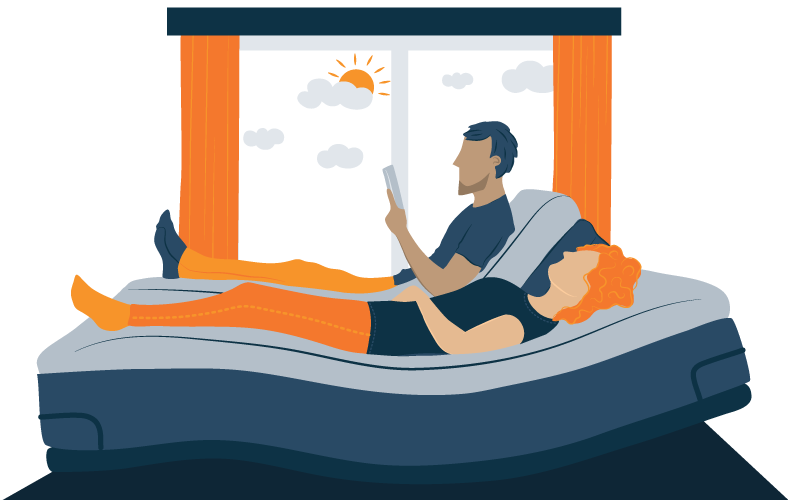Ever heard the term ‘floating in space’? Imagine experiencing that sensation while you’re asleep. One of the most innovative bedtime concepts is sleeping in zero gravity. The idea is to create a sleeping environment that feels similar to floating in space, with minimal gravity pressuring on our joints.
This experience is no longer only reserved for astronauts, though. Thanks to the help of a zero-gravity bed, this style of mattress and frame could offer tremendous relief to those who live with aches and pains. If you’re curious to know what it’s all about, this guide will cover the ins and outs of zero-gravity sleeping and how you could benefit.
What Is the Zero-Gravity Sleep Position?
The term “zero gravity” refers to a specific position originally inspired by NASA. In preparation for a shuttle launch, astronauts were placed into a neutral body posture as a way to evenly distribute their weight and minimize the pressure on their bodies.1
The style uses a mattress and frame to position the body in a way that relieves pressure from common pain points like the lower back, hips, and shoulders. By minimizing the stress in these areas, the bed helps to offer a more comfortable sleeping experience and alleviate pain.
How to Get in the Zero-Gravity Sleep Position
If you have an adjustable bed, you can easily get into the zero-gravity position. Some adjustable beds already have a zero-gravity preset button. If yours does, you can use it to automatically place yourself in the correct posture.
Related: Best Mattresses for Adjustable Beds and Best Adjustable Bed Fames here.
When setting the position, you will start off laying flat on your back. You’ll then raise the upper and lower part of your bed so that your head and knees so that they’re above your heart and stomach. Lastly, you’ll want to create a slight bend for your knees with the bottom portion of the base.
Side Sleeping in the Zero-Gravity Position
You can also choose to sleep on your side in in the zero-gravity position. The same rules apply as above. Start by lying on your preferred side, then raise your head and knees until they’re just above your heart and stomach.
However, you should avoid stomach sleeping in the zero-gravity posture as this could severely misalign your spine and lead to increased discomfort.
Benefits of the Zero-Gravity Sleeping Position
This style of sleeping might seem fancy and futuristic, but it has some substantial benefits for your health and body.

1. Reduces Snoring and Eases Breathing
When you lay on your back, throat and neck tissue can obstruct your airways. Elevating your upper body in the zero-gravity posture opens up your air passages for better breathing. The raised position could help alleviate multiple issues including asthma, sleep apnea, respiratory conditions, allergies, and even the occasional stuffy nose.
Additionally, if you or your partner’s snoring gets in the way of peaceful nights, this could be an excellent solution to a good night’s rest.
Get More Info: Best Mattress for Snoring
2. Decreases Heartburn and Acid Reflux
The irony of zero-gravity sleep is that it’s a smart way to let gravity help at the same time. This is especially true for easing heartburn and acid reflux.
Gastroesophageal Reflux Disease (GERD) occurs when acids that normally are restricted to the stomach bubble up into the esophagus.2 Acid reflux is the compound that rises up, and heartburn is a painful symptom of this that occurs in the chest. Remaining upright during the night allows gravity to pull those acids back down to the stomach.
3. May Improve Insomnia and Promote Deeper Sleep
The concept behind the zero-gravity sleep position is that it’s designed to reduce stress on your body by removing pressure on your muscles and joints. This heightened state of relaxation could help you fall asleep more easily and remain in a deeper state of sleep.
4. Boosts Circulation
By keeping your legs and torso elevated, the zero-gravity posture should improve circulation because it allows the heart to pump blood more efficiently. You can improve this even further by lying on your left side specifically, which experts say boosts blood flow.3
Want to know more? Read our guide for sleeping with legs elevated.
5. Better Digestion
Sleeping in an upright posture also benefits the digestive system. The same way gravity is used to alleviate GERD by pulling things down, it also helps get the food you eat into your stomach. When the upper body is elevated, food can pass through the esophagus and into the stomach easier than when lying down flat.
Learn More: How Digestion Affects Your Sleep Quality
6. Back and Neck Pain Relief
There are excellent flat beds on the market designed to ease the strain on the body’s pressure points, but if you are still experiencing back and neck pain, a zero-gravity bed could be the relief you need. This is because your spine is in a neutral position with less pressure on it, which was the original intent behind the zero-gravity position.
Get More Info: How Can Adjustable Beds Help with Back Pain
7. Reduces Swelling
A benefit of zero-gravity sleep is that it could curb swelling in the legs, feet, and ankles. As mentioned, your legs are raised while in the zero-gravity posture, and according to experts, lifting the legs is helpful for alleviating swelling in these areas because of the improved circulation.4
Frequently Asked Questions
Is it okay to sleep in a zero-gravity position?
The zero-gravity position could not only help you sleep better and reduce pain, but it could also promote heart health, digestive health, and respiratory health. With these medical benefits, it’s a considerably healthy way to rest. That being said, you can also apply this position to things other than sleep, like reading or watching television.
If overall health is a focus, or you have a particular health condition mentioned above, it may be a wise choice to invest in an adjustable bed that will allow you to achieve this sleep position in your everyday life.
Is a zero-gravity bed good for your heart?
Yes, as mentioned above, a zero-gravity bed could improve your heart health by increasing circulation throughout your body and taking pressure off the heart.
Conclusion
With a varied assortment of health benefits that extend far beyond getting a good night’s rest, a zero-gravity bed may arguably be one of the most innovative and appealing products on today’s market. The sleep position’s capabilities include improved circulation, better digestion, reduced snoring, easing back and neck pain, and more.
This sleeping style is particularly great for back and side sleepers, who may need even more relief for sensitive pressure points and aches than a traditional flat bed could offer. So, while a trip to outer space may not be on your itinerary at the moment, for now, you and your joints can at least experience a weightless, zero-gravity sensation as you sleep.

Jill Zwarensteyn
Editor
About Author
Jill Zwarensteyn is the editor for Sleep Advisor and a certified sleep science coach. She is enthusiastic about providing helpful and engaging information on all things sleep and wellness.
Combination Sleeper
Education & Credentials
- Certified Sleep Science Coach
References:
- “Neutral Body Posture Specifications”. NASA. 2016.
- “Gastroesophageal reflux disease (GERD)”. Mayo Clinic. Last modified January 4, 2024.
- Howland, Jason. “Mayo Clinic Minute: What is the best sleeping position?”. Mayo Clinic. 2024.
- Lakhanpal, Sanjiv. “Top Tips to Elevate Legs and Mistakes to Avoid”. Center for Vascular Medicine. Webpage accessed July 10, 2024.
